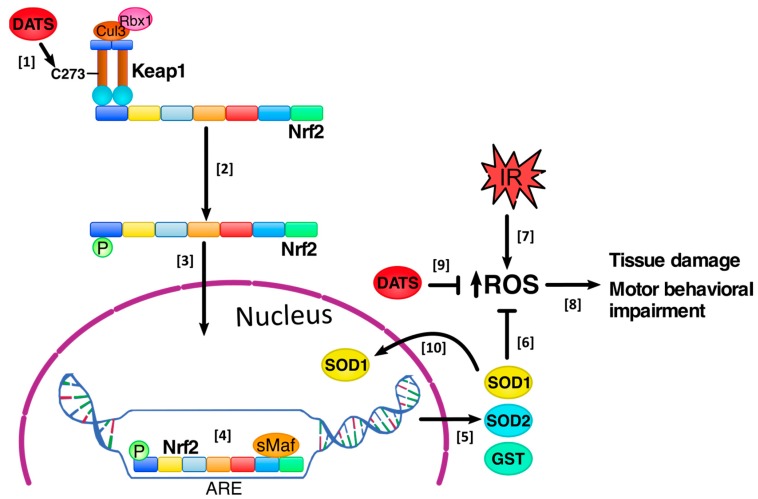Figure 10.
Diallyl trisulfide (DATS) protected the brain tissue against the damage induced by ischemia/reperfusion (IR). [1] DATS administration every 24 h for 4 days, starting 5 min before the onset of reperfusion, induced the release of the nuclear factor erythroid 2 related factor 2 (Nrf2) from the Kelch like ECH-associated protein 1 (Keap1), possibly through the direct interaction between DATS with the cysteine 273 (C273) in Keap1, inducing a conformational change in Keap1’s structure, [2] releasing Nrf2 and inducing its phosphorylation and [3] nuclear translocation. [4] In the nucleus, Nrf2 is dimerized with small musculoaponeurotic fibrosarcoma (sMaf) proteins and binds to the antioxidant response elements (ARE), [5] inducing the expression of antioxidant enzymes such as superoxide dismutase 1 (SOD1) and SOD2 and the phase 2 enzyme glutathione S-transferase (GST) [6]. These enzymes decrease reactive oxygen species (ROS) levels induced by the IR insult. [7] The IR induced an increase in ROS production, [8] which induce tissue damage and motor behavioral impairment; however, DATS treatment avoided tissue damage and improved motor behavioral impairment. [9] Additionally, there is a possibility that DATS reacted with the ROS generated during the IR, reducing their levels due to its direct antioxidant properties, protecting the brain tissue [10]. Finally, DATS treatment increased the total levels of SOD1 and its nuclear translocation, which could be important in preventing DNA oxidation by ROS, maintaining genomic stability. Rbx1 = RING-box protein 1, Cul3 = Cullin-3.

